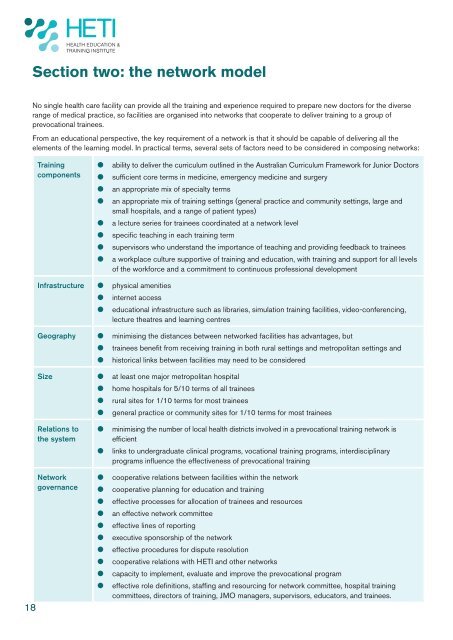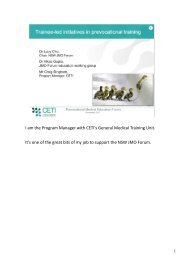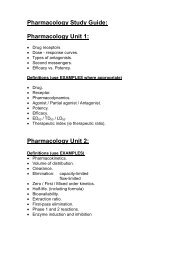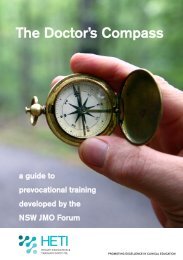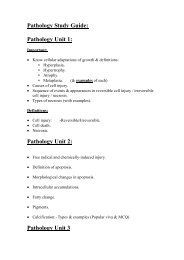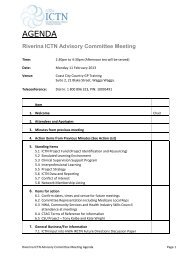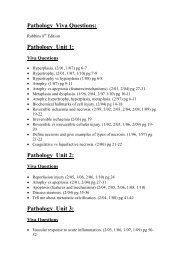Network principles for prevocational medical training - HETI
Network principles for prevocational medical training - HETI
Network principles for prevocational medical training - HETI
Create successful ePaper yourself
Turn your PDF publications into a flip-book with our unique Google optimized e-Paper software.
Section two: the network model<br />
No single health care facility can provide all the <strong>training</strong> and experience required to prepare new doctors <strong>for</strong> the diverse<br />
range of <strong>medical</strong> practice, so facilities are organised into networks that cooperate to deliver <strong>training</strong> to a group of<br />
<strong>prevocational</strong> trainees.<br />
From an educational perspective, the key requirement of a network is that it should be capable of delivering all the<br />
elements of the learning model. In practical terms, several sets of factors need to be considered in composing networks:<br />
18<br />
Training<br />
components<br />
Infrastructure<br />
Geography<br />
Size<br />
Relations to<br />
the system<br />
<strong>Network</strong><br />
governance<br />
• z ability to deliver the curriculum outlined in the Australian Curriculum Framework <strong>for</strong> Junior Doctors<br />
• z sufficient core terms in medicine, emergency medicine and surgery<br />
• z an appropriate mix of specialty terms<br />
• z an appropriate mix of <strong>training</strong> settings (general practice and community settings, large and<br />
small hospitals, and a range of patient types)<br />
• z a lecture series <strong>for</strong> trainees coordinated at a network level<br />
• z specific teaching in each <strong>training</strong> term<br />
• z supervisors who understand the importance of teaching and providing feedback to trainees<br />
• z a workplace culture supportive of <strong>training</strong> and education, with <strong>training</strong> and support <strong>for</strong> all levels<br />
of the work<strong>for</strong>ce and a commitment to continuous professional development<br />
• z physical amenities<br />
• z internet access<br />
• z educational infrastructure such as libraries, simulation <strong>training</strong> facilities, video-conferencing,<br />
lecture theatres and learning centres<br />
• z minimising the distances between networked facilities has advantages, but<br />
• z trainees benefit from receiving <strong>training</strong> in both rural settings and metropolitan settings and<br />
• z historical links between facilities may need to be considered<br />
• z at least one major metropolitan hospital<br />
• z home hospitals <strong>for</strong> 5/10 terms of all trainees<br />
• z rural sites <strong>for</strong> 1/10 terms <strong>for</strong> most trainees<br />
• z general practice or community sites <strong>for</strong> 1/10 terms <strong>for</strong> most trainees<br />
• z minimising the number of local health districts involved in a <strong>prevocational</strong> <strong>training</strong> network is<br />
efficient<br />
• z links to undergraduate clinical programs, vocational <strong>training</strong> programs, interdisciplinary<br />
programs influence the effectiveness of <strong>prevocational</strong> <strong>training</strong><br />
• z cooperative relations between facilities within the network<br />
• z cooperative planning <strong>for</strong> education and <strong>training</strong><br />
• z effective processes <strong>for</strong> allocation of trainees and resources<br />
• z an effective network committee<br />
• z effective lines of reporting<br />
• z executive sponsorship of the network<br />
• z effective procedures <strong>for</strong> dispute resolution<br />
• z cooperative relations with <strong>HETI</strong> and other networks<br />
• z capacity to implement, evaluate and improve the <strong>prevocational</strong> program<br />
z • effective role definitions, staffing and resourcing <strong>for</strong> network committee, hospital <strong>training</strong><br />
committees, directors of <strong>training</strong>, JMO managers, supervisors, educators, and trainees.


